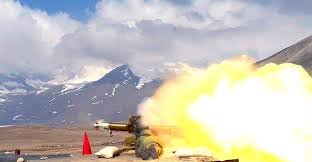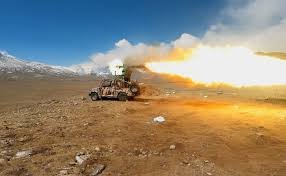Indian Army Conducts Anti-Tank Guided Missile Training Exercise in Sikkim
The Indian Army recently conducted a comprehensive training exercise focused on anti-tank guided missiles in the picturesque region of Sikkim. This exercise aimed to enhance the combat capabilities of the army and strengthen its preparedness to tackle any potential threats along the borders. The exercise took place in the challenging terrain of Sikkim, which closely resembles the conditions prevalent in the border areas, thereby providing the soldiers with realistic training experience.
The training exercise involved the deployment of various types of anti-tank guided missiles, including state-of-the-art systems, to simulate different combat scenarios. Soldiers received rigorous training in handling, operating, and effectively utilizing these advanced weapons systems to neutralize enemy tanks and armored vehicles. Additionally, the exercise focused on improving coordination among different units of the army, including infantry and mechanized forces, to ensure seamless integration during combat operations.
The strategic significance of conducting such exercises in Sikkim cannot be overstated. As a border state, Sikkim shares its boundaries with China and Nepal, making it a critical region from a defense perspective. By conducting training exercises in this region, the Indian Army demonstrates its commitment to maintaining a robust defense posture along the sensitive border areas.

Why this News is Important:
Enhancing Combat Preparedness : The Indian Army’s recent training exercise on anti-tank guided missiles in Sikkim holds immense importance for several reasons.
Strategic Significance: The strategic location of Sikkim, with its borders adjoining China and Nepal, underscores the significance of strengthening defense capabilities in the region. Training exercises conducted here are crucial for maintaining a strong deterrence against potential threats along the borders.
Technological Advancements: The use of state-of-the-art anti-tank guided missiles highlights the army’s focus on leveraging advanced technology to enhance its combat effectiveness. By familiarizing soldiers with these modern weapons systems, the army ensures that they are well-equipped to face contemporary security challenges.
Terrain Familiarization: Sikkim’s challenging terrain closely resembles the conditions prevalent in the border areas, making it an ideal location for conducting realistic training exercises. Soldiers trained in such environments are better prepared to tackle the complexities of mountain warfare.
Coordination and Integration: The exercise emphasized the importance of coordination and integration among different units of the army, including infantry and mechanized forces. This interoperability is vital for achieving synergy and maximizing combat effectiveness during operations.
Deterrence Against Aggression: By showcasing its preparedness through such exercises, the Indian Army sends a clear message of deterrence to potential adversaries. It reaffirms India’s commitment to safeguarding its territorial integrity and sovereignty.
Historical Context:
Background of Anti-Tank Guided Missile Training Exercise in Sikkim
In recent years, India has witnessed escalating tensions along its borders, particularly in regions adjacent to China and Nepal. The strategic importance of Sikkim, with its proximity to these border areas, has necessitated the enhancement of defense capabilities in the region. Historically, Sikkim has served as a buffer state between India and Tibet, playing a crucial role in the geopolitics of the region.
The Indian Army has long recognized the significance of training exercises in preparing for potential threats along the borders. The rugged terrain and adverse weather conditions prevalent in Sikkim closely resemble the challenges faced by soldiers in the border areas, making it an ideal location for conducting such exercises. Over the years, the army has conducted numerous training programs and maneuvers in Sikkim to enhance its readiness for various contingencies.
The recent focus on anti-tank guided missile training underscores the evolving nature of modern warfare and the need for specialized skills and equipment to counter emerging threats. By continually updating its training methodologies and incorporating advanced technologies, the Indian Army remains at the forefront of defense preparedness in the region.
Key Takeaways from “Indian Army Conducts Anti-Tank Guided Missile Training Exercise in Sikkim”
| Serial Number | Key Takeaway |
|---|---|
| 1. | Strategic significance of Sikkim in defense preparedness |
| 2. | Utilization of state-of-the-art anti-tank guided missiles |
| 3. | Importance of terrain familiarization for realistic training |
| 4. | Emphasis on coordination and integration among army units |
| 5. | Significance of deterrence in maintaining peace and security |
Important FAQs for Students from this News
1. Q: Why did the Indian Army conduct the anti-tank guided missile training exercise in Sikkim?
A: The Indian Army conducted the exercise to enhance its combat capabilities and strengthen preparedness to tackle potential threats along the borders, especially in the challenging terrain resembling border conditions.
2. Q: What types of anti-tank guided missiles were deployed during the training exercise?
A: Various types of anti-tank guided missiles, including state-of-the-art systems, were deployed to simulate different combat scenarios and provide soldiers with hands-on experience in handling modern weaponry.
3. Q: Why is Sikkim considered a strategic location for conducting such training exercises?
A: Sikkim shares its borders with China and Nepal, making it strategically significant for defense preparedness. Its rugged terrain and adverse weather conditions closely resemble those found in the border areas, offering realistic training environments.
4. Q: What is the historical significance of Sikkim in relation to Indian defense strategy?
A: Historically, Sikkim has served as a buffer state between India and Tibet, playing a crucial role in the geopolitics of the region. Its proximity to sensitive border areas has necessitated the enhancement of defense capabilities in the region.
5. Q: How does the training exercise contribute to India’s deterrence strategy?
A: By showcasing its preparedness through such exercises, the Indian Army sends a clear message of deterrence to potential adversaries, reaffirming India’s commitment to safeguarding its territorial integrity and sovereignty.
Some Important Current Affairs Links

















